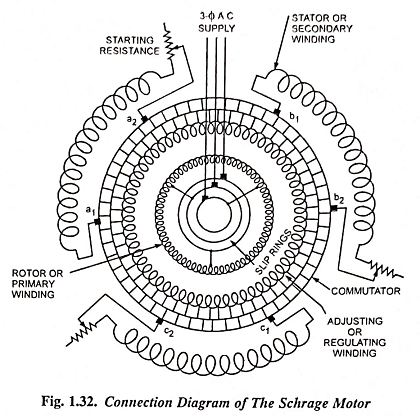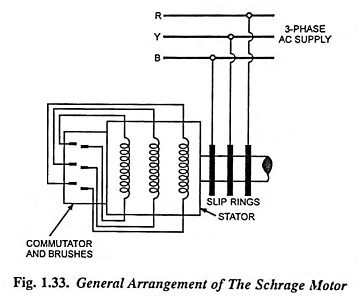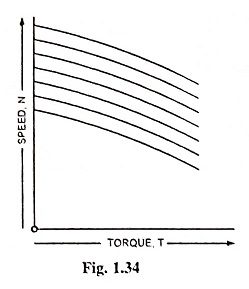Schrage Motor – Connection Diagram, Advantages, Disadvantages and Applications:
Variable Speed Commutator Type 3-Phase Induction Motor (Schrage Motor). This is also an improvement of the plain induction motor designed to provide a variable speed. It also consists of a commutator winding placed on the rotor in addition to primary winding, whose emf is collected and injected into the secondary winding, placed on the stator. It is provided with two sets of brushes, as illustrated in Figs. 1.32 and 1.33.
The speed can be controlled over 3 to 1 range by moving the brush sets relatively to one another in opposite directions. The speed which depends upon the total emf induced in the secondary winding, will be affected by the injected emf. The speed will decrease if the injected emf is in phase opposition to the induced emf and will increase if the injected emf is in phase with the induced emf. Some power factor control can be had by moving both the brush sets together in the same direction. The operating power factor is high.
Speed-torque characteristic curves are shown in Fig. 1.34. The output power available from the machine is directly proportional to the operating speed. Maximum operating torque ranges from 140 to 250% of full-load speed.
Advantages:
The main advantages of the Schrage motor are
- continuous speed regulation within the required range
- high power factor for high speed settings
- high efficiency at all speeds except synchronous speed and very much high at lower speeds.
Disadvantages:
One major drawback of the Schrage motor is that its operating voltage is limited about to 700 V, because the power is to be supplied to the motor through the slip rings. Other disadvantages are its low power factor at low speed settings and its poor commutation and high cost.
Applications of Schrage Motor:
Schrage motor is used only where adjustable speed is required as in bakery, machinery, stokers, printing machines, calenders etc.
One important application of the Schrage motor is to drive the hosiery-knitting and ring-spinning machines, where an automatically controlled speed variation of 10 to 30% is often required. They are also used for a wide range of industrial services, driving fans, pumps, conveyors, packaging machinery, paper mills etc. Sizes up to several hundred kW have been built. They are normally rated on a constant torque basis, the kW output varying in direct proportion to the speed.


